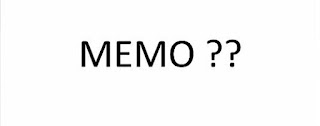Understanding Memo Writing
The primary purpose of writing a memo is to support decision-making by
documenting a reference for future use. It also helps in conveying information,
presenting an informal report, and proposing a solution to a problem.
A business memo is appropriate to use when making company announcements such as employee appointments, promotions and changes in company policies.
Format of a Memo
A memo normally includes the following elements:
a) Organization name – in the letterhead.
b) Memo Title – at the top of the page.
c) Attachments – documents attached to the memo for reference.
d) Summary – placed at the beginning of the memo, should condense the subject to five or ten lines. It should not contain jargon or highly technical language.
e) To – Reader’s full name (include honorary titles, but keep generic titles like ‘Mr.’, ‘Ms.’ out. The ‘To’ line negates salutation usages like ‘Dear’.
A business memo is appropriate to use when making company announcements such as employee appointments, promotions and changes in company policies.
Format of a Memo
A memo normally includes the following elements:
a) Organization name – in the letterhead.
b) Memo Title – at the top of the page.
c) Attachments – documents attached to the memo for reference.
d) Summary – placed at the beginning of the memo, should condense the subject to five or ten lines. It should not contain jargon or highly technical language.
e) To – Reader’s full name (include honorary titles, but keep generic titles like ‘Mr.’, ‘Ms.’ out. The ‘To’ line negates salutation usages like ‘Dear’.
f) If the number of readers exceed five, mention them at the end of the memo under ‘Distribution List’ and refer to it on the ‘To’ line. For example- To:
g) From - The name and designation of the sender is mentioned here. It negates complimentary closes like ‘With Regards’.
h) Date - Mentioning the date helps in tracking the memo.
i) Subject - Mention the topic in a few words (5-6) but it should clearly state the purpose.
j) Message - This section contains Introduction, Discussion (contains 2-3 middle paragraphs mentioning the details), and a Conclusion.
g) From - The name and designation of the sender is mentioned here. It negates complimentary closes like ‘With Regards’.
h) Date - Mentioning the date helps in tracking the memo.
i) Subject - Mention the topic in a few words (5-6) but it should clearly state the purpose.
j) Message - This section contains Introduction, Discussion (contains 2-3 middle paragraphs mentioning the details), and a Conclusion.
- Introduction – States the memo’s purpose and scope. In the case of good news, bad news, refusal, rejection or approval, a short message is mentioned here before providing the details in the Discussion Section.
- Discussion – Details of the problem, the approach to solving it, analysis, evaluation, and recommendations are mentioned here.
- Conclusion – Rounds up the main points and provides necessary action and directions for the readers.
k) Distribution list – Names on the distribution list are usually typed in alphabetical order. However, if one of the individuals clearly outranks the others, place that name first.
l) Writer’s initials – A memo is completed by the writer’s initials, not his/her signature, immediately after the last sentence.
l) Writer’s initials – A memo is completed by the writer’s initials, not his/her signature, immediately after the last sentence.



Comments
Post a Comment
Disclaimer: Opinions expressed in comments are those of the comment writers alone and does not reflect or represent Toprhythm's view.